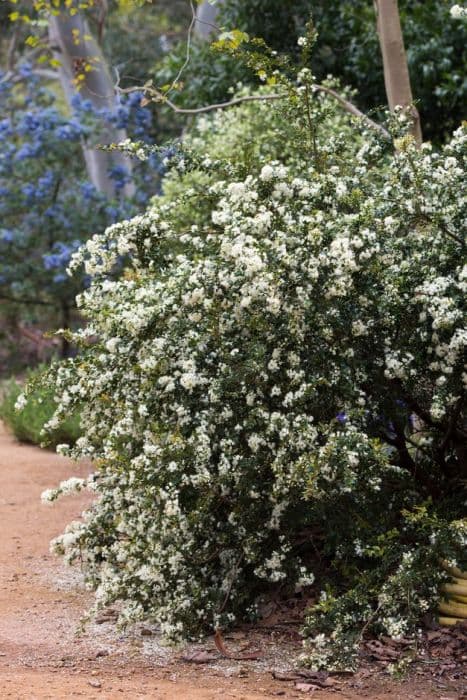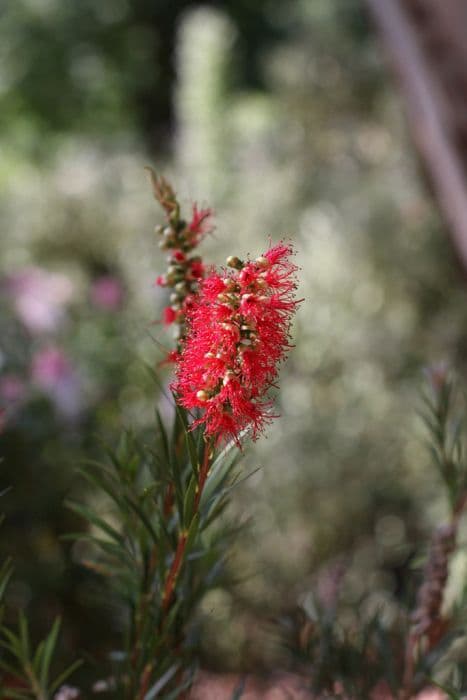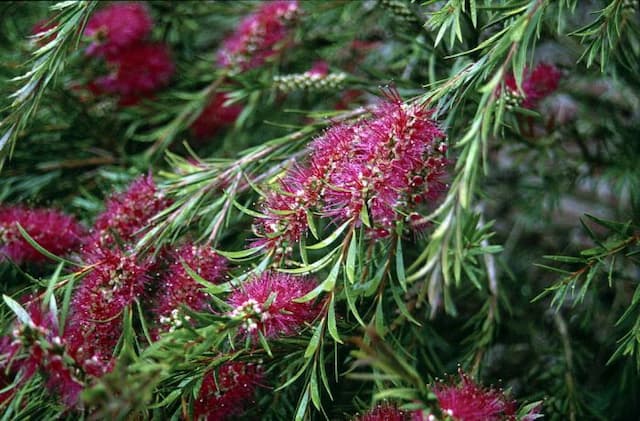Willow Bottlebrush Callistemon salignus

ABOUT
The plant commonly known as Willow Bottlebrush is a visually striking species with a number of distinctive features. Its most noteworthy characteristic is the prolific flowering that gives it its common name. The flowers of Willow Bottlebrush are vibrant, typically appearing in various shades of red or pink, with numerous long stamens that create a brush-like effect, reminiscent of a bottle cleaner. The leaves of the Willow Bottlebrush are another defining aspect of its appearance. They are slender and slightly curved, resembling those of a willow tree, which is reflected in its common name. These leaves typically present a light green to grey-green color and may have a silvery sheen. Bark on the trunk and branches varies from smooth to flaky but is generally pale in hue, contributing to the plant's overall soft and inviting aesthetic. The overall form of Willow Bottlebrush is one of a graceful and weeping habit, with branches that droop gently, creating a canopy that is both elegant and offers a sense of tranquility. The graceful foliage, combined with the striking flowers, provides a plant that is highly regarded for both ornamental and habitat purposes in suitable climates.
About this plant
 Names
NamesFamily
Myrtaceae
Synonyms
Willow Bottlebrush, White Bottlebrush
Common names
Metrosideros saligna, Melaleuca salicina, Callistemon pallidus, Callistemon salignus var. pallidus.
 Toxicity
ToxicityTo humans
Callistemon salignus, commonly known as the Willow Bottlebrush, is not widely recognized as a toxic plant to humans. There is no significant evidence that suggests ingestion of this plant causes poisoning. However, as with many plants, individuals with specific allergies may experience reactions, and it is always advisable to avoid ingesting plants that are not confirmed to be edible.
To pets
Willow Bottlebrush, the common name for Callistemon salignus, is also not widely known to be toxic to pets. There is limited information regarding its effects if ingested by animals, but there is no prominent evidence that points to it as a source of poisoning. As with humans, it's still prudent to prevent pets from ingesting non-food plants to avoid any potential for an allergic reaction or gastrointestinal upset.
 Characteristics
CharacteristicsLife cycle
Perennials
Foliage type
Evergreen
Color of leaves
Green
Flower color
White
Height
15-25 feet (4.5-7.6 meters)
Spread
10-15 feet (3-4.5 meters)
Plant type
Tree
Hardiness zones
9
Native area
Australia
Benefits
 General Benefits
General Benefits- Ornamental value: Callistemon salignus, commonly known as White bottlebrush, is admired for its aesthetic appeal due to its beautiful white to cream-colored flowers and attractive foliage.
- Habitat for wildlife: The White bottlebrush provides nectar and pollen for bees and other pollinating insects, as well as a habitat for birds that feed on its flowers.
- Drought tolerance: This plant is known for its resilience and ability to withstand periods of low water availability, making it suitable for xeriscaped gardens and drought-prone regions.
- Erosion control: With a robust root system, Callistemon salignus helps in stabilizing soils and preventing erosion, particularly on slopes or banks.
- Low maintenance: It requires minimal care once established, with little need for fertilizers or regular watering, making it an excellent choice for low-maintenance landscaping.
- Adaptability: The White bottlebrush is adaptable to a range of soil types, including poor soils, which reduces the need for soil amendment and makes it easy to incorporate into a variety of landscapes.
- Windbreak: Its dense foliage and relatively fast growth make it an effective windbreak or privacy screen when planted in rows or as a hedge.
- Cultural significance: In some cultures, the White bottlebrush is used for ceremonial or decorative purposes, adding cultural value to this species.
 Medical Properties
Medical Properties- There is currently no documented evidence supporting the medical uses of Callistemon salignus which is commonly known as Willow Bottlebrush.
 Air-purifying Qualities
Air-purifying QualitiesThis plant is not specifically known for air purifying qualities.
 Other Uses
Other Uses- Woodworking: The wood of the White bottlebrush is suitable for woodworking, including the creation of small wooden crafts and as turnery for ornamental items.
- Dye Source: The bark and leaves of the White bottlebrush can be used to extract natural dyes for textile coloring.
- Erosion Control: White bottlebrush is often planted on slopes and riverbanks to help stabilize soil and prevent erosion.
- Windbreaks: Due to its robust nature, White bottlebrush can be planted as part of windbreaks to protect smaller, more sensitive plants from strong winds.
- Privacy Screening: With its dense foliage, the White bottlebrush can be grown as a hedge or screen for added privacy in gardens and yards.
- Biomass Production: White bottlebrush can be used in biomass plantations for the production of renewable energy, due to its fast growth and high biomass yield.
- Craft Materials: The dried flowers of the White bottlebrush can be used in floral arrangements, wreaths, and other craft projects.
- Beekeeping: White bottlebrush is an excellent source of nectar, making it an attractive plant for beekeepers to encourage pollination and honey production.
- Ecological Projects: White bottlebrush is often included in native planting schemes and habitat restoration projects due to its hardiness and low maintenance requirements.
- Noise Reduction: When planted in mass, White bottlebrush can help to reduce noise pollution, acting as a buffer against urban sounds.
Interesting Facts
 Feng Shui
Feng ShuiThe Bottlebrush is not used in Feng Shui practice.
 Zodiac Sign Compitability
Zodiac Sign CompitabilityThe Bottlebrush is not used in astrology practice.
 Plant Symbolism
Plant Symbolism- Resilience: The callistemon salignus, commonly known as the Willow Bottlebrush, is known for its ability to withstand harsh conditions, symbolizing resilience in the face of adversity.
- Purification: Known for its brush-like flowers that seem to sweep away impurities, the Willow Bottlebrush is often associated with cleansing and starting anew.
- Attraction: With its vibrant red flowers that attract birds and insects, the Willow Bottlebrush symbolizes attraction and the power to draw in what one desires.
- Bravery: The bold appearance of the flower spikes can symbolize courage and the willingness to stand out.
 Water
WaterThe Willow Bottlebrush should be watered regularly during its first growing season to establish a deep root system. Watering once a week with about 1 to 1.5 gallons per watering should suffice. Once established, it's more drought-tolerant and will need less frequent watering. During the hot season, increase the frequency to twice a week but adjust based on rainfall and soil moisture levels. Always check the top few inches of soil for dryness before watering to avoid overwatering.
 Light
LightThe Willow Bottlebrush thrives in full sun to partial shade. The ideal spot provides direct sunlight for at least 6 to 8 hours a day. If located indoors, a sunny window or a room with ample natural light will be beneficial for the plant's growth. Avoid placing it in deep shade as it can hinder blooming and overall vitality.
 Temperature
TemperatureWillow Bottlebrush prefers a warm climate with temperatures ranging from 40 to 90 degrees Fahrenheit. The plant can survive temperatures down to around 20 degrees Fahrenheit but may suffer damage from frost. Ideal growing conditions are within the 70 to 85 degrees Fahrenheit range for optimal growth and flowering. Protect the plant from extreme cold by providing shelter or covering.
 Pruning
PruningPruning the Willow Bottlebrush is essential for maintaining its shape and encouraging a more compact growth. Prune after the flowering season, typically in late spring or early summer, to remove any dead or diseased branches and to shape the plant. You may also thin out the center to increase air circulation. It is not necessary to prune every year; doing it every 2 to 3 years or as needed to control size is sufficient.
 Cleaning
CleaningAs needed
 Soil
SoilWillow Bottlebrush thrives in well-draining, sandy loam that is slightly acidic to neutral in pH, ideally between 6.0 and 7.0. A soil mix of 2 parts sand, 2 parts topsoil, and 1 part compost or peat moss works well.
 Repotting
RepottingWillow Bottlebrush should be repotted every 2-3 years to prevent becoming root-bound and to refresh the soil, allowing for healthy growth.
 Humidity & Misting
Humidity & MistingWillow Bottlebrush prefers moderate to high humidity levels but is adaptable to average household humidity conditions.
 Suitable locations
Suitable locationsIndoor
Place in bright, indirect light and ensure good air circulation for Willow Bottlebrush.
Outdoor
Plant in full sun and protect from harsh winds for Willow Bottlebrush.
Hardiness zone
8-11 USDA
 Life cycle
Life cycleThe life cycle of Callistemon salignus, commonly known as White Bottlebrush, begins with seed germination, which occurs in moist soil conditions following dispersal by wind or wildlife. The seedling stage follows, marked by the emergence of the first leaves and establishment of a root system. As the plant enters the vegetative growth stage, it develops a woody stem and the characteristic lance-shaped leaves. Upon reaching maturity, which may take several years, the White Bottlebrush produces vibrant flower spikes composed of numerous individual blossoms that attract pollinators like birds and insects. After pollination, the flowers develop into woody capsules which contain seeds that will be released when mature, completing the reproductive cycle. This species also has the ability to resprout from the lignotuber after events such as bushfires, providing another means of survival and regeneration.
 Propogation
PropogationPropogation time
Spring-Early Summer
Propogation: The most popular method of propagating Callistemon salignus, commonly known as Willow Bottlebrush, is through semi-hardwood cuttings. This generally takes place during the late summer to early fall. To propagate, one would take cuttings of about 4 to 6 inches (10 to 15 cm) in length from the current year's growth, ensuring each cutting has several leaf nodes. Leaves are typically removed from the lower half of the cutting. The cut end is often dipped in rooting hormone to encourage root development and then placed in a well-draining potting mix. The cuttings are kept moist and in a warm environment with indirect sunlight. Roots usually develop in a few weeks, after which the new plants can gradually acclimate to outdoor conditions before being transplanted to their final location.









